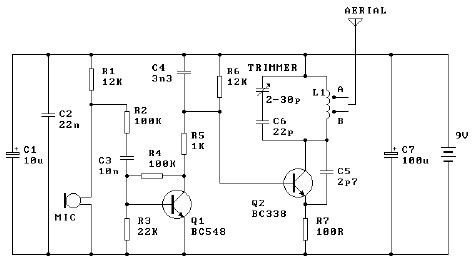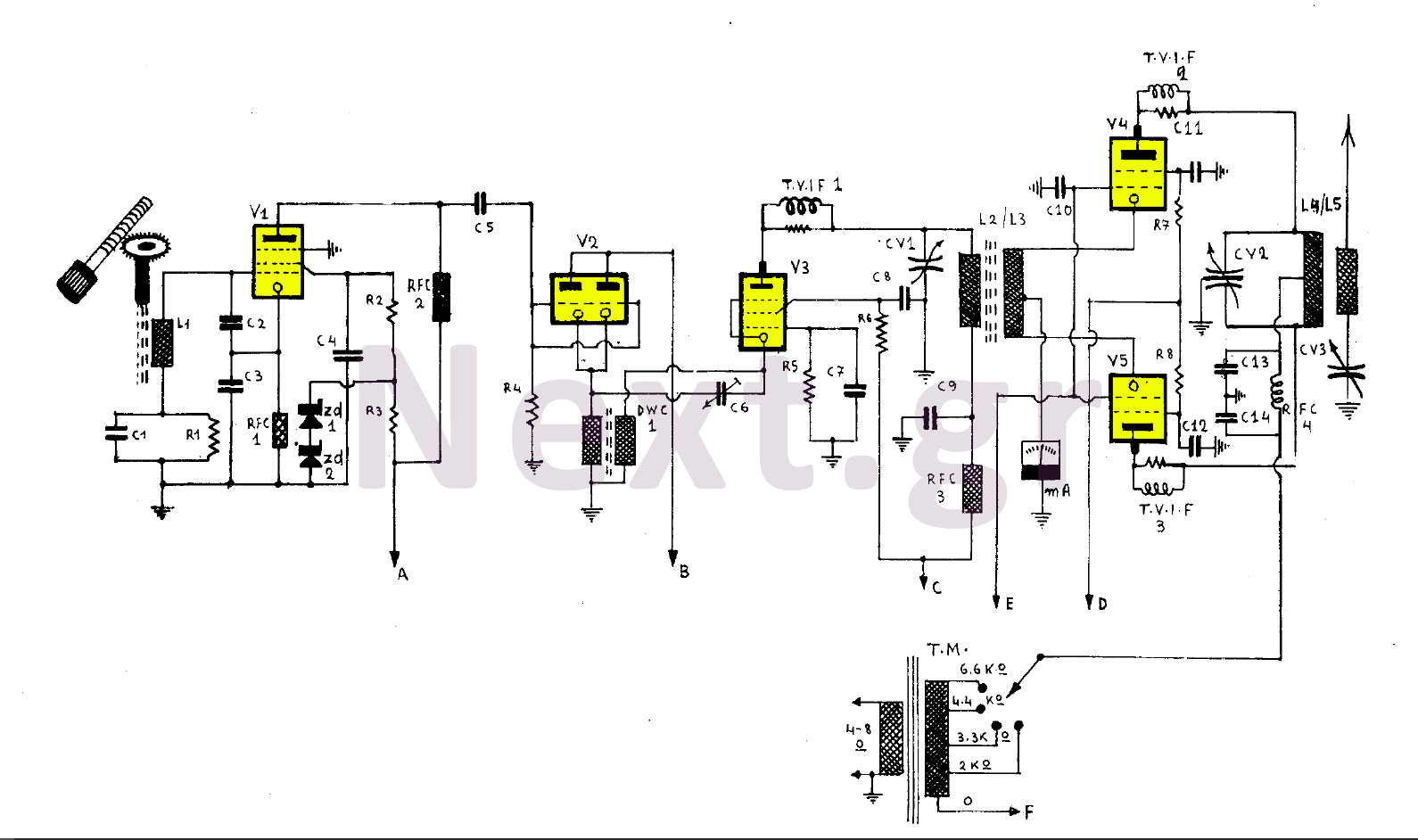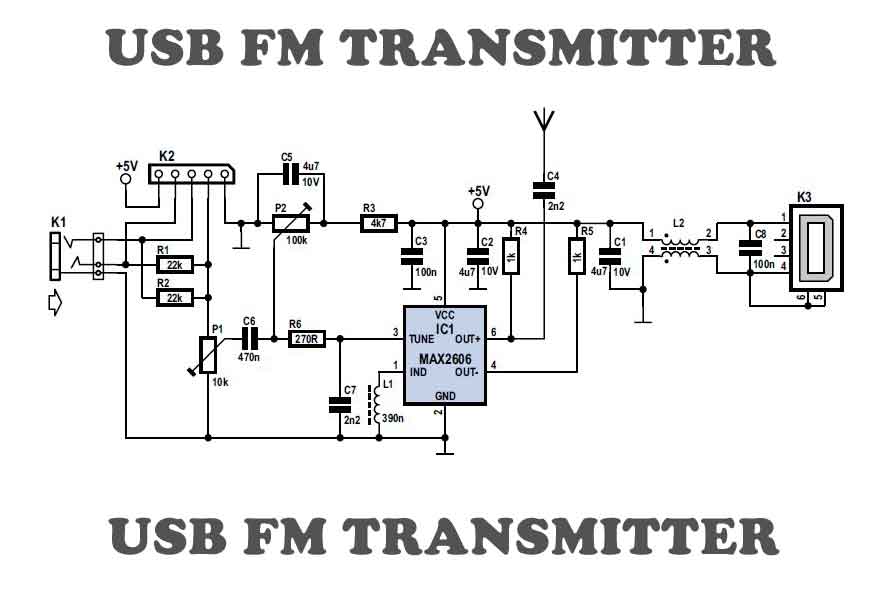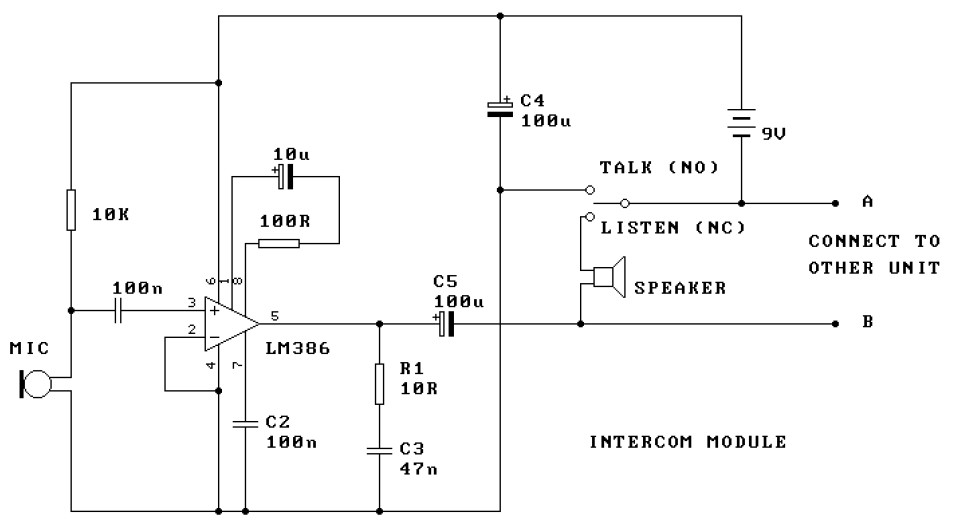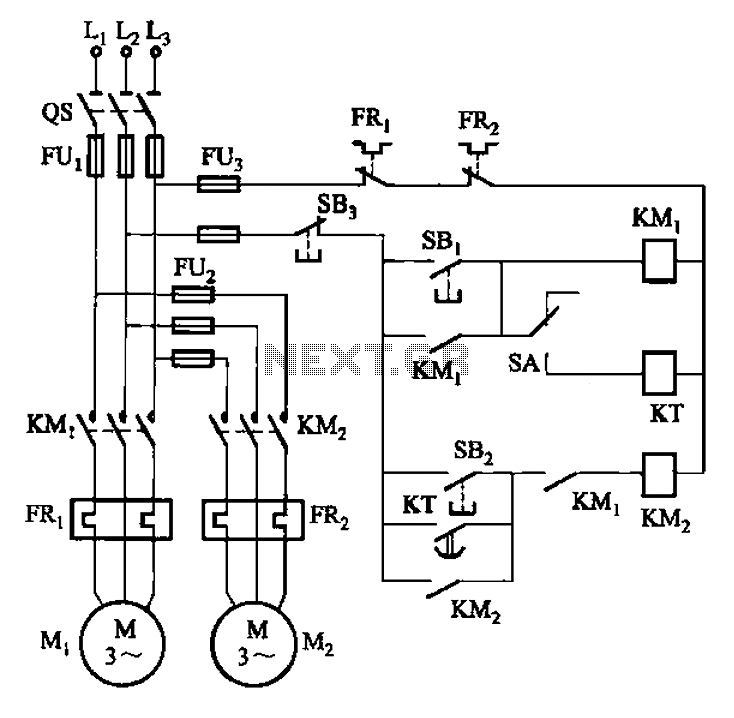
Two Tube AM Transmitter
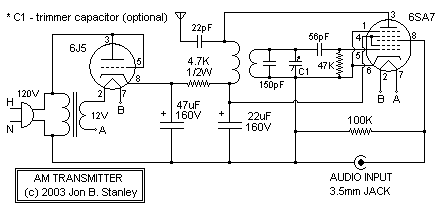
A functional AM transmitter has been completed, primarily based on Phil's Li'l 7 Transmitter design. Achieving oscillation in LC-based transmitters can be challenging without the correct combination of tubes and coils. This transmitter utilizes a 6J5 and a 6SA7 tube, operating around 1400 kHz on the AM band. The schematic diagram of the transmitter is provided. The antenna coil was repurposed from an old radio's oscillator circuit, which had a 455 kHz intermediate frequency. The coil features two windings, one with a higher DC resistance, indicated as the larger winding in the schematic. If oscillation is absent on the antenna of the 6SA7, reversing the connections to one of the coil windings may resolve the issue. The plate current from the 6SA7 generates a magnetic field in the larger winding, inducing current in the other coil. The coil must be oriented correctly to push the grid negative, reducing plate current, which in turn decreases grid current and allows more plate current to flow. The oscillations are regulated by the LC circuit comprising the grid coil and a 150 pF capacitor. A trimmer capacitor in parallel with the 150 pF allows for slight adjustments to the carrier frequency. If oscillations do not commence, reversing the windings might assist. Modulation is achieved by feeding audio into the second grid of the 6SA7 tube, controlling the plate current with the audio signal. This results in the oscillator signal being superimposed with the audio signal, creating an amplitude-modulated output. The 6J5, a general-purpose triode, functions as a low-power half-wave rectifier in this circuit, with the power supply providing approximately 140 VDC under load. Although the 6J5 was available, it is advisable to use a tube designed for rectification, such as a 6X4. Caution is advised, as an isolation transformer or power transformer is recommended due to one side of the mains being connected to the ground side of the audio input. The plug should be polarized to ensure the circuit sees neutral. If the plug is reversed, the ground shield of the audio cable could become live, posing a risk of shorting with AC-powered audio equipment. A portable CD player or audio device is recommended for use with this transmitter to avoid AC polarity conflicts. Members of the Antique Radio Forum (ARF) offered parts for a successful 6888-based AM transmitter. The 6888 is a unique octal tube described as a "dual control pentode," with both the first grid and suppressor grid functioning as control grids. In the kit design, a 6AB4 or 6C4 is utilized as an audio preamp, while the 6888 serves as the transmitting tube. The schematic of this design is also provided. The circuit is relatively straightforward for a transmitter, with notable features including a 1 MHz crystal oscillator that requires 5 volts and produces a square wave output at that frequency. These oscillators are typically used in TTL or computer circuits, as they are self-contained rather than relying solely on a crystal. The cathode current from the 6888 is adequate to power the crystal oscillator, regulated by a 1N4733 (5V 1W zener). The oscillator output controls the first grid of the 6888, generating a clean 1 MHz carrier on the plate. An inductor and trimmer capacitor above the plate of the 6888 function as a tuned LC tank, with the trimmer capacitor adjusting the output strength and range of the transmitter, maximizing range when the LC circuit resonates at 1 MHz.
The AM transmitter circuit described is an example of a classic design that utilizes vacuum tubes for signal generation and modulation. The 6SA7 tube, functioning as a mixer and oscillator, is critical in creating the AM signal. Its operation hinges on the interaction between the grid and plate currents, which modulate the signal based on the audio input. The design's use of an LC circuit for frequency stability and modulation is a hallmark of analog transmitter designs, allowing for fine-tuning of both frequency and output power.
The 6888 tube's unique structure enables it to serve dual roles, enhancing the transmitter's performance. The inclusion of a crystal oscillator not only stabilizes the frequency but also simplifies the design by eliminating the need for external frequency control components. The careful selection of components such as the trimmer capacitor and the zener diode ensures that the transmitter operates efficiently and safely.
Safety precautions are paramount in this design, particularly regarding the power supply and grounding. The recommendation for an isolation transformer is critical in preventing electrical hazards, especially in a home-built transmitter where the risk of accidental miswiring exists. Overall, this AM transmitter design reflects a blend of traditional techniques with modern safety considerations, making it suitable for hobbyists and educational purposes.I finally completed a working AM transmitter. The transmitter`s design is based on several ideas, but mainly based on Phil`s Li`l 7 Transmitter design. It is not always easy to achieve oscillation in LC-based transmitters without the right combination of tubes and coils.
The tubes used in this transmitter is a 6J5 and 6SA7 th at operates at around 1400kHz on the AM band. Below is the schematic diagram of the transmitter. The antenna coil was salvaged from the oscillator circuit in a typical old radio with a 455kHz I. F. frequency. The coil generally has two windings; one with a larger DC resistance than the other and is indicated as the larger winding in the schematic. If there is no oscillation present on the antenna of the 6SA7 then reversing the connections to one of the coil windings usually does the trick.
The plate current by the 6SA7 causes the larger winding to generate a magnetic field that induces current in the other coil. The coil has to be the correct polarity to push the grid negative to reduce plate current. When the plate current reduces then the grid current reduces and allows more plate current to flow. The oscillations are controlled by the LC circuit consisting of the grid coil and the 150pF capacitor.
The trimmer capacitor in parallel with the 150pF allows small range adjustment of the carrier frequency. If oscillations do not start, flipping around windings might help. Modulation is achieved by feeding audio in the second grid of the 6SA7 tube so the plate current is controlled by the audio signal.
As a result, the oscillator signal and the audio signal are superimposed upon each other resulting in an amplitude modulated signal, hence it is an AM transmitter! The 6J5 is a triode designed for general purposes, but in this transmitter it serves as a low power half-wave rectifier in this circuit.
The power supply provides about 140VDC loaded. The 6J5 was one of the few tubes I could find in my junk box at the time, but I would recommend using a tube that is actually designed for rectification purposes such as a 6X4. BEWARE! An isolation transformer or some sort of power transformer is highly recommended because one side of mains is connected to the ground side of the audio input.
The plug must be polarized so this side of the circuit sees the neutral. If the plug were accidently reversed and the ground shield of the audio cable were to become hot then it could potentially SHORT out with most, if not all, AC powered audio equipment. I only use a portable CD player or audio device with this transmitter to avoid conflicts with AC polarity.
Some fellow ARF ( Antique Radio Forum ) members offered to send me some parts to get started on a quite successful 6888-based AM transmitter. The 6888 is an oddball octal tube that goes by the description of "dual control pentode" because its first grid and supressor grid both are used as a control grid.
In the kit design, a 6AB4 or 6C4 is used as an audio preamp and the 6888 as the transmitting tube. Below is a schematic of the transmitter as designed by members on ARF. The circuit is fairly straight forward for a transmitter but there are some noteworthy features. The 1MHz crystal oscillator requires 5 volts and produces a nice square wave output at 1MHz. These oscillators are normally used in TTL or computer circuits because it is a self-contained oscillator rather than a mere crystal. The cathode current by the 6888 is sufficient to provide power to the crystal oscillator and a 1N4733 (5V 1W zener) is used to regulate the voltage.
The oscillator output controls the first grid of the 6888 to create a clean 1MHz carrier on the plate. The inductor and trimmer capacitor above the plate of the 6888 serves as a tuned LC tank. The trimmer capacitor will adjust the output strength and thereby the range of the transmitter. The range is largest when the LC circuit resonates at 1MHz. For use with st 🔗 External reference
The AM transmitter circuit described is an example of a classic design that utilizes vacuum tubes for signal generation and modulation. The 6SA7 tube, functioning as a mixer and oscillator, is critical in creating the AM signal. Its operation hinges on the interaction between the grid and plate currents, which modulate the signal based on the audio input. The design's use of an LC circuit for frequency stability and modulation is a hallmark of analog transmitter designs, allowing for fine-tuning of both frequency and output power.
The 6888 tube's unique structure enables it to serve dual roles, enhancing the transmitter's performance. The inclusion of a crystal oscillator not only stabilizes the frequency but also simplifies the design by eliminating the need for external frequency control components. The careful selection of components such as the trimmer capacitor and the zener diode ensures that the transmitter operates efficiently and safely.
Safety precautions are paramount in this design, particularly regarding the power supply and grounding. The recommendation for an isolation transformer is critical in preventing electrical hazards, especially in a home-built transmitter where the risk of accidental miswiring exists. Overall, this AM transmitter design reflects a blend of traditional techniques with modern safety considerations, making it suitable for hobbyists and educational purposes.I finally completed a working AM transmitter. The transmitter`s design is based on several ideas, but mainly based on Phil`s Li`l 7 Transmitter design. It is not always easy to achieve oscillation in LC-based transmitters without the right combination of tubes and coils.
The tubes used in this transmitter is a 6J5 and 6SA7 th at operates at around 1400kHz on the AM band. Below is the schematic diagram of the transmitter. The antenna coil was salvaged from the oscillator circuit in a typical old radio with a 455kHz I. F. frequency. The coil generally has two windings; one with a larger DC resistance than the other and is indicated as the larger winding in the schematic. If there is no oscillation present on the antenna of the 6SA7 then reversing the connections to one of the coil windings usually does the trick.
The plate current by the 6SA7 causes the larger winding to generate a magnetic field that induces current in the other coil. The coil has to be the correct polarity to push the grid negative to reduce plate current. When the plate current reduces then the grid current reduces and allows more plate current to flow. The oscillations are controlled by the LC circuit consisting of the grid coil and the 150pF capacitor.
The trimmer capacitor in parallel with the 150pF allows small range adjustment of the carrier frequency. If oscillations do not start, flipping around windings might help. Modulation is achieved by feeding audio in the second grid of the 6SA7 tube so the plate current is controlled by the audio signal.
As a result, the oscillator signal and the audio signal are superimposed upon each other resulting in an amplitude modulated signal, hence it is an AM transmitter! The 6J5 is a triode designed for general purposes, but in this transmitter it serves as a low power half-wave rectifier in this circuit.
The power supply provides about 140VDC loaded. The 6J5 was one of the few tubes I could find in my junk box at the time, but I would recommend using a tube that is actually designed for rectification purposes such as a 6X4. BEWARE! An isolation transformer or some sort of power transformer is highly recommended because one side of mains is connected to the ground side of the audio input.
The plug must be polarized so this side of the circuit sees the neutral. If the plug were accidently reversed and the ground shield of the audio cable were to become hot then it could potentially SHORT out with most, if not all, AC powered audio equipment. I only use a portable CD player or audio device with this transmitter to avoid conflicts with AC polarity.
Some fellow ARF ( Antique Radio Forum ) members offered to send me some parts to get started on a quite successful 6888-based AM transmitter. The 6888 is an oddball octal tube that goes by the description of "dual control pentode" because its first grid and supressor grid both are used as a control grid.
In the kit design, a 6AB4 or 6C4 is used as an audio preamp and the 6888 as the transmitting tube. Below is a schematic of the transmitter as designed by members on ARF. The circuit is fairly straight forward for a transmitter but there are some noteworthy features. The 1MHz crystal oscillator requires 5 volts and produces a nice square wave output at 1MHz. These oscillators are normally used in TTL or computer circuits because it is a self-contained oscillator rather than a mere crystal. The cathode current by the 6888 is sufficient to provide power to the crystal oscillator and a 1N4733 (5V 1W zener) is used to regulate the voltage.
The oscillator output controls the first grid of the 6888 to create a clean 1MHz carrier on the plate. The inductor and trimmer capacitor above the plate of the 6888 serves as a tuned LC tank. The trimmer capacitor will adjust the output strength and thereby the range of the transmitter. The range is largest when the LC circuit resonates at 1MHz. For use with st 🔗 External reference
